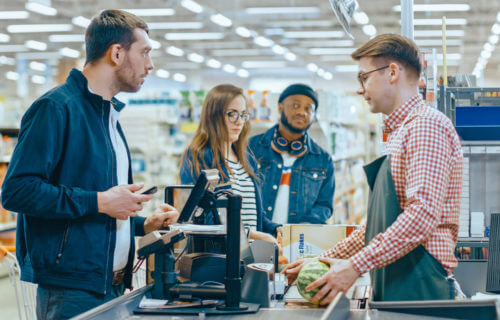NEW YORK — It’s probably a good idea to eat before you head off to the supermarket for a food run. New research shows that grocery shopping on an empty stomach can lead to some serious overspending. In fact, the average person will fork out an extra $26 per trip when they’re hungry!
The poll of 2,000 Americans found that most people make two grocery runs per week, with a budget of $162. But here’s the thing – more than three-quarters of respondents (76%) admitted they’re more likely to blow their budget if they shop while hungry. And six in ten said they’re also likely to forget about their health goals when their stomach is rumbling.
So, how much extra are we talking? Well, 62% of people said they typically spend up to 20% more than they’d planned. Only a fifth (20%) reported that they never overspend on groceries.
Grocery Store Shopping Habits
The study, conducted by OnePoll and commissioned by Dole Food Company for National Banana Day on Apr. 17, took a deep dive into Americans’ grocery and produce shopping habits, food needs, and priorities when it comes to eating well.
On average, people need to visit two stores each week to find everything they need, and a typical grocery run takes 39 minutes. Most people are shopping to feed two (or more), while 30% are just shopping for themselves.
Want to avoid the crowds? The best time to shop is 8:00 a.m. – 9:59 a.m. The worst time? 4:00 p.m. – 5:59 p.m. And the most popular time is 10:00 a.m – 11:59 a.m.
Over half of Americans (56%) shop with a grocery list, and 79% of those who do said they’re less likely to overspend. Interestingly, three in four (74%) said their grocery hauls are similar to what their parents would buy when they were kids.
Brand loyalty is a big deal for some – 41% of people have preferred brands and are willing to visit an extra store to find them if their usual store is out of stock. In fact, 39% of Americans are willing to pay more for brands that are transparent about their sourcing, supply chain, and environmental sustainability.
On average, people would be willing to pay nearly 10% more if it meant they could have the highest quality produce and nutrient-dense, healthy foods.
What Do You Buy At The Supermarket?
So, what are the “must-haves” for every grocery trip? Bread (54%), eggs (52%), meat (51%), milk or milk substitutes (50%), coffee (35%), and bananas (35%). But get this – 60% of respondents had no idea that bananas are the most-purchased grocery item in the U.S.!
“A high-quality food shouldn’t break the bank. It should nourish us, be ethically sourced and should be readily available to consumers,” said William Goldfield, director of corporate communications for Dole. “We believe health should be our highest priority and should be reflected in the way people shop. For our 125th anniversary of growing and marketing bananas, we commissioned this study to look at how Americans spend on what’s important to them when it comes to food and their hierarchy of food needs.”
The survey found that Americans prioritize food variety (35%), quick and convenient foods (34%), protein-rich foods (32%), and inexpensive foods (30%).
When it comes to what influences their purchases, price (55%), flavor (48%), availability (23%), and nutrients (21%) are the top factors.
And those impulse buys at the checkout line? Bananas (33%), grapes (30%), and apples (22%) are the most likely to end up in your cart.
Finally, the survey settled the great banana debate: 50% of people said the perfect time to eat a banana is when it’s yellow with no spots. But a surprising 6% prefer their bananas mostly green!
“Bananas are often accused of being high in sugar content. However, the truth is bananas are a nutrient-dense, inexpensive food full of dietary fiber and vitamins B6 and C that should be part of your diet. Whole foods are intrinsically good for us,” said Goldfield. “We know bananas as a quick snack or addition to a meal, supporting heart health and energy metabolism.”
Survey methodology:
This random double-opt-in survey of 2,000 general population Americans was commissioned by Dole between Mar. 14 and Mar. 18, 2024. It was conducted by market research company OnePoll, whose team members are members of the Market Research Society and have corporate membership to the American Association for Public Opinion Research (AAPOR) and the European Society for Opinion and Marketing Research (ESOMAR).
